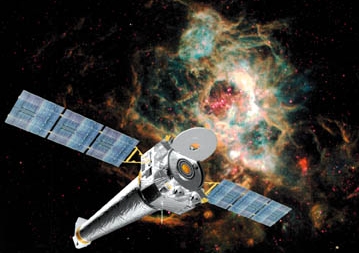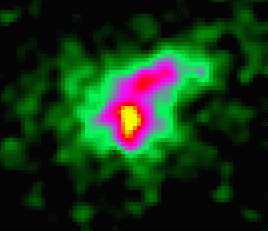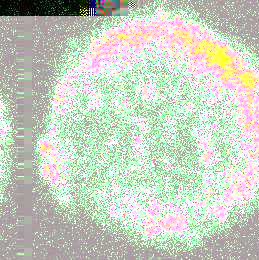| Chandra X-Ray Observatory | |||||
 |
|||||
|---|---|---|---|---|---|
| The third of NASA's Great Observatories for Space Astrophysics | |||||
| Chandra | Science | Spectrum | History | Resources | Great Observatories |
| Chandra X-Ray Observatory | |||||
 |
|||||
|---|---|---|---|---|---|
| The third of NASA's Great Observatories for Space Astrophysics | |||||
| Chandra | Science | Spectrum | History | Resources | Great Observatories |

X-rays from distant objects in deep space cannot be observed from on the ground because Earth's atmosphere blocks them. Only instruments placed above and beyond the atmosphere can measure energy from supernova remnants, quasars, neutron stars and black holes.
NASA helped pioneer the development of x-ray astronomy, but the last NASA x-ray mission before Chandra was the High Energy Astronomy Observatory (HEAO-2), nicknamed the Einstein Observatory. It was called that because it was launched in 1979, the centennial year of physicist Albert Einstein's birth. A landmark in the development of astronomy, the Einstein Observatory provided the first true images of x-ray-emitting objects.
Chandra X-Ray Observatory. During design and construction, the future Chandra X-Ray Observatory was known as the Advanced X-Ray Astrophysics Facility (AXAF).
In 1998, AXAF was renamed in honor of the late Indian-American Nobel laureate astrophysicist Subrahmanyan Chandrasekhar.
The U.S. space shuttle Columbia ferried the Chandra X-ray Observatory to Earth orbit on July 23, 1999.
When work first started on AXAF back in 1977, NASA's Marshall Space Flight Center was preparing to launch the first High Energy Astronomy Observatory (HEAO) spacecraft to give scientists their best views of the Universe in x-rays, gamma rays and cosmic radiation.
Einstein Observatory. Chandra's most important Earth-orbing predecessor was the second High Energy Astronomy Observatory (HEAO-2). The HEAO-2 spacecraft, also known as the Einstein Observatory, carried what was then the largest focusing x-ray telescope.
HEAO-2's telescope was a 4-in-1 apparatus, four telescopes nested within each other. Each comprised a primary mirror and a secondary mirror to focus X-rays and magnify the image.

Because X-rays carry enough energy to penetrate most materials, the mirrors are shaped more like shallow tubes than the more familiar dish-shaped mirrors in visible light telescopes. At a shallow angle, the X-rays just graze and reflect, just as sunlight glares off a window if the angle is right.
As advanced as HEAO-2 was in the 1970s, NASA was planning something bigger -- the future Chandra X-Ray Observatory.
AXAF, to be renamed Chandra, was the follow-on to HEAO-2. Chandra's telescope has four nested mirror arrays offering three times the collecting area of HEAO-2. During an observing session, Chandra sees a small portion of sky with details eight times finer than HEAO-2, and catches events at double the energy as HEAO-2. That is ten versus five keV.
NASA has been involved with two-dozen high-energy astrophysics spacecraft projects over the years.
Europe's XMM. Five months after it was launched, NASA's Chandra X-ray Observatory was joined in orbit above Earth in December 1999 by a European counterpart, the European Space Agency's X-ray Multi-Mirror (XMM) satellite. Like Chandra, XMM is designed to explore the X-ray sky, which is invisible to ground-based telescopes. XMM is said to be five times more sensitive than Chandra. However, Chandra has a sharper view, so the two missions are complementary and there is close transatlantic collaboration among the scientists involved.
The scientific objectives of both satellites are finding out exactly what goes on in the vicinity of black holes, clearing up the mystery of stupendous explosions called gamma-ray bursts, investigating cannibalism among stars, understanding the release of newly made chemical elements from stellar explosions, and discovering the origin of cosmic rays that rain on Earth. CHANDRA PHOTO ALBUM
Chandra Science Spectrum History Resources
Hubble Compton SIRTF Great Observatories Telescopes Deep Space
Search STO About STO Questions Suggestions Feedback E-Mail
© 2002 Space Today Online E-mail